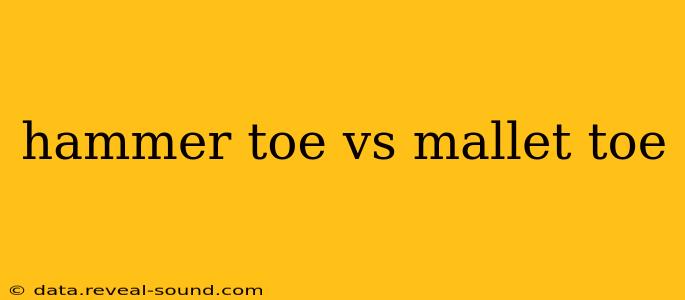Hammer toe and mallet toe are both deformities of the toes, causing them to bend abnormally. While they share similarities, understanding their key differences is crucial for proper diagnosis and treatment. This article will delve into the specifics of each condition, highlighting their causes, symptoms, and treatment options.
What is Hammer Toe?
Hammer toe is a deformity affecting the middle joint of the toe (the proximal interphalangeal joint, or PIP joint). This joint bends abnormally, creating a claw-like appearance. The toe's tip may also bend downward. This condition can affect any toe, but it’s most common in the second, third, and fourth toes.
Symptoms of Hammer Toe:
- A bent middle joint of the toe.
- A noticeable bump on the top of the affected joint.
- Calluses or corns on the top of the toe joint or the tip of the toe.
- Pain and discomfort, especially when wearing shoes.
- Limited mobility of the affected toe.
Causes of Hammer Toe:
- Ill-fitting shoes: Tight shoes that constrict the toes are a primary cause. High heels and pointed-toe shoes are notorious offenders.
- Muscle imbalances: Weakness or imbalance in the muscles of the foot can contribute to the deformity.
- Arthritis: Joint inflammation from arthritis can lead to hammer toe.
- Injury: A previous injury to the toe can sometimes contribute to the development of hammer toe.
- Hereditary factors: In some cases, hammer toe can be hereditary.
What is Mallet Toe?
Mallet toe is similar to hammer toe but affects the joint closest to the toenail (the distal interphalangeal joint, or DIP joint). This joint bends abnormally, causing the toe tip to curl downward. Unlike hammer toe, the middle joint of the toe usually remains relatively straight. It most often affects the smaller toes.
Symptoms of Mallet Toe:
- A bent joint at the tip of the toe.
- Calluses or corns on the tip of the toe.
- Pain and discomfort, particularly when wearing shoes.
- Limited mobility of the affected toe.
Causes of Mallet Toe:
Many of the causes of mallet toe mirror those of hammer toe:
- Ill-fitting shoes: Again, tight shoes are a major contributor.
- Muscle imbalances: Foot muscle imbalances can play a role.
- Injury: Trauma to the toe can lead to the development of mallet toe.
- Hereditary factors: Genetic predisposition can increase the risk.
- Rheumatoid arthritis: This inflammatory condition can affect the joints of the toes.
What are the Differences Between Hammer Toe and Mallet Toe?
The primary difference lies in the affected joint:
- Hammer toe: Affects the middle joint of the toe (PIP joint).
- Mallet toe: Affects the joint closest to the toenail (DIP joint).
This difference in location leads to a slightly different appearance. Hammer toe creates a more pronounced bend in the middle of the toe, while mallet toe results in a curled-down tip. Both conditions, however, can cause pain, discomfort, and calluses.
How are Hammer Toe and Mallet Toe Treated?
Treatment options for both conditions are similar and often depend on the severity of the deformity and the presence of pain:
- Conservative Treatments: These are often tried first and include wearing properly fitting shoes, using toe pads or splints to straighten the toe, and over-the-counter pain relievers. Orthotic devices can help support the arch of the foot and improve balance.
- Surgical Correction: If conservative treatments fail, surgery may be recommended. Surgical procedures involve realigning the bones and tendons of the affected toe. Several different surgical techniques are available, selected based on the specific deformity and the patient's overall health.
Can Hammer Toe or Mallet Toe be Prevented?
While genetics can play a role, many cases are preventable. Wearing properly fitting shoes is crucial. Avoid shoes that are too tight, narrow, or have high heels. Regular foot exercises can also help strengthen the foot muscles and maintain flexibility. Addressing any underlying foot conditions promptly is important to prevent further complications.
What if I think I have Hammer Toe or Mallet Toe?
It is important to consult a podiatrist or another healthcare professional for a proper diagnosis. They can assess your specific condition and recommend the appropriate treatment plan. Self-treating can sometimes worsen the condition.
This information is for general knowledge and does not constitute medical advice. Always seek professional medical advice for any health concerns.
